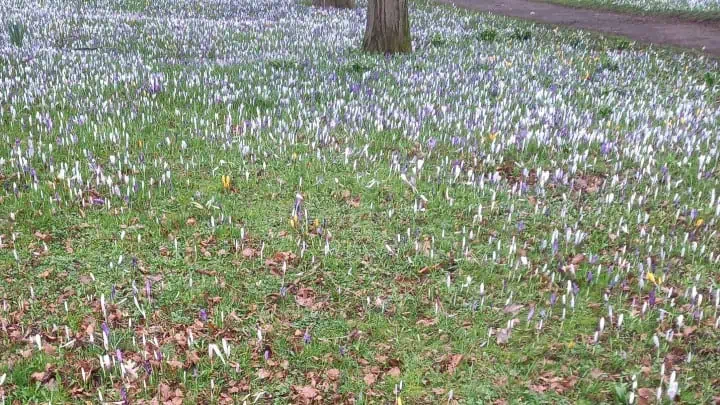Friday Reflections

Last week I was walking back from our Darlington office and came across the carpet of Crocuses that Vic has hopefully added to this post somewhere, I have always loved Crocuses. They announce spring to me like no other plant – to me they trump the daffodils and snowdrops.
I love that they can appear anywhere, that they can be blue, white, yellow or purple seemingly in the same patch and, that like daisies they are one of the few flowers we happily tolerate in a well-tended lawn. Having already said Crocuses twice I can confirm that the vernacular plural of crocus is a personal choice so either a carpet of crocuses or a chorus of croci is fine to use.
From what I have read the name Crocus comes from the Greek work for Saffron – as the Saffron Crocus is where the spice is harvested from and then used in cooking, for fragrances and for dying. Many people associate the crocus with happiness, rebirth, joy and cheerfulness. It is generally recognized as a symbol of hope that the dark days of winter are at an end and that life will return and flourish.
The different colours also hold symbolic meaning – white for honesty, truth, and purity. Often used at both funerals and weddings. The purple crocus flower symbolizes hope, dignity, success and pride. Orange for hardiness, blue sadly for those who are disheartened and yellow for love. Buddhist monks favoured dying their robes yellow because they associated the Saffron flower with humility and renunciation.
The Crocus appears in the traditional Jewish Song of Solomon. The flower being the symbol of spirituality and is dedicated to St. Valentine (which makes sense given the time of year).
Greek mythology tell the story of the mortal youth named Crocus being a lover of the Messenger God Hermes. The lovers were said to be undertaking athletic pursuits when a discus thrown by Hermes hit Crocus upon the head, mortally wounding him. The grief-stricken Hermes transformed his lover into a flower, and three drops of blood, that had fallen from the head of Crocus, became the stigmata of the flower (which is the saffron).
This alternate version of the Crocus myth say’s that the mortal Crocus was in love with the nymph, Smilax. Sadly the love offered by Crocus was either unrequited or forbidden, so he died of a broken heart, the Gods in their pity transformed him into the flower.
Both myths are tragic, but both symbolise a romantic devotion. Roman myths also refer to the Crocus as an emblem of love, often used in love potions.
I love how such a unintrusive and undemanding little flower can elicit so much symbolism and generate its own myths, stories and meanings. How it can represent love and rebirth, how it bides its time through the hard months of winter and reappear with full flourish as the first signs of a warm sun. the lesson is gives us is perhaps best summed up by Miss H.F. Gould in her book The Poetry of Flowers:
“Many, perhaps, from so simple a flower,
This little lesson may borrow,
Patient today, through its gloomiest hour,
We come out the brighter tomorrow.”



